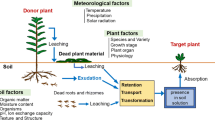Abstract
Araucaria forest, named due to the high abundance of Araucaria angustifolia, occurs mainly in the southern Brazilian highlands, and the abundance of A. angustifolia in the forest is a current forest issue. The present study aimed at evaluating a potential allelopathic effect of A. angustifolia needle extracts that could mediate plant successional dynamics in the Araucaria forests. Senescent araucaria needles from A. angustifolia were evaluated for their allelopathic potential on Lactuca sativa through an in vitro study. The effect was evaluated by determining the germination of seeds, length of seedling and germination rate. The allelopathic potential of the A. angustifolia was confirmed for the highest doses tested (187.5 and 250 mg of the extracts). The potential allelochemical compounds identified were ent-kaurene and phyllocladene. In conclusion, A. angustifolia showed a potential allelophatic effect that may play an important role in successional dynamics of Araucaria forests.



Similar content being viewed by others
References
Adams RP (2007) Identification of essential oil components by gas chromatography/mass spectrometry. Allured, Illinois
Alrababah MA, Tadros MJ, Samarah NH, Ghosheh H (2009) Allelopathic effects of Pinus halepensis and Quercus coccifera on the germination of Mediterranean crop seeds. New For 38:261–272
Baretta D, Brescovit AD, Knysak I, Cardoso EJBN (2007) Trap and soil monolith sampled edaphic spiders (Arachnida: Araneae) in Araucaria angustifolia forest. Sci Agric 64:375–383
Behling H (1997) Late Quaternary vegetation, climate and fire history of the araucaria forest and campos region from Serra Campos Gerais, Paraná State (South Brazil). Rev Palaeobot Palyno 97:109–121
Behling H (1998) Late Quaternary vegetational and climatic changes in Brazil. Rev Palaeobot Palyno 99:143–156
Beutling A, Batista AC, Soares RV, Vitorino MD (2005) Quantificação de Material combustível superficial em reflorestamentos de Araucaria angustifolia (Bert.) O. Ktze. Floresta 35:465–473
Blum U (1996) Allelopathic interactions involving phenolic acids. J Nematol 28:259–267
Briggs LH, White GW (1975) Constituents of the essential oil of Araucaria araucana. Tetrahedron 31:1311–1314
Brophy JJ, Goldsack RJ, Wu MZ, Fookes CJR, Forster PI (2000) The steam volatile oil of Wollemia nobilis and its comparison with other members of the Araucariaceae (Agathis and Araucaria). Biochem Syst Ecol 28:563–578
Campello JP, Fonseca SF (1975) Diterpenes from Araucaria angustifolia. Phytochemistry 14:2299–2300
Carvalho PER (1994) Espécies arbóreas brasileiras, vol 1. Embrapa Informação Tecnológica, Brasília
Ding L, Qi L, Jing H, Li J, Wang W, Wang T (2008) Phytotoxic effects of Leukamenin E (an ent-kaurene diterpenoid) on root growth and root hair development in Latuca sativa L. seedlings. J Chem Ecol 34:1492–1500
Fernandes LAV, Miranda DLC, Sanquetta CR (2007) Potencial alelopático de Merostachys multiramea Hackel sobre a germinação de Araucaria angustifolia (BERT.) Kuntze. Ver Acad 5:139–146
Fernandez C, Lelong B, Vila B, Mévy JP, Robles C, Greff S, Dupouyet S, Bousquet-Mélou A (2006) Potential allelopathic effect of Pinus halepensis in the secondary succession, an experimental approach. Chemoecology 16:97–105
Fernandez C, Voiriot S, Mévy JP, Vila B, Ormeño E, Dupouyet S, Bousquet-Mélou A (2008) Regeneration failure of Pinus Halepensis Mill.: the role of autotoxicity and some abiotic environmental parameters. For Ecol Manag 225:2928–2936
Fernandez C, Monnier Y, Ormeño E, Baldy V, Greff S, Pasqualini V, Mévy J, Bousquet-Mélou A (2009) Variations in allelochemical composition of leachates of different organs and maturity stages of pinus halepensis. J Chem Ecol 35:970–979
Ferreira AG, Aquila MEA (2000) Alelopatia: uma área emergente da ecofisiologia. Rev Bras Fisiol Veg 12:175–204
Kato-Noguchi H, Fushimi Y, Shigemori H (2009) An allelophatic substance in red pine needles (Pinus densiflora). J Plant Physiol 166:442–446
Kil BS (1992) Effect of pine allelochemicals on selected species in Korea. In: Rizvi SJH, Rizvi V (eds) Allelopathy basic applied aspects. Chapman and Hall, London, pp 205–241
Li ZH, Wang Q, Ruan X, Pan CD, Zhang JC, Jiang DA, Wang GG (2011) Biological activity and quantification of potential autotoxins from Picea schrenkiana leaves. Allelopath J 27:245–262
Macías FA, Molinillo JMG, Galindo JCG, Varela RM, Torres A, Simonet AM (1999) Terpenoids with potential use as natural herbicide templates. In: Cutler HG, Culter SJ (eds) Biological active natural products: agrochemicals. CRC, Boca Raton, pp 15–31
Moreira-Souza M, Cardoso EJBN (2003) Pratical method for germination of Araucaria angustifolia (Bert.) O. Ktze. seeds. Sci Agr 60:389–391
Nandal DPS, Bisla SS, Narwal SS, Kaushik JC (1994) Allelopathic interactions in agroforestry systems. In: Narwal SS, Tauro P (eds) Allelopathy in agriculture and forestry. Scientific Publishers, Jodhpur, pp 93–130
Putnam AR, Defrank J, Barnes JP (1983) Exploitation of allelopathy for weed control in annual and perennial cropping systems. J Chem Ecol 9:1001–1011
Reigosa MJ, Gonzalez L, Souto XC, Pastoriza JE (2000) Allelopathy in forest ecosystems. In: Tauro P (ed) Allelopathy in ecological agriculture and forestry. Kluwer, The Netherlands, pp 183–193
Rice EL (1984) Allelopathy, 2nd edn. Academic, Orlando
Roderjan CV, Galvão F, Kuniyoshi YS, Hatschbach GG (2002) As unidades fitogeográficas do estado do Paraná. Ciênc Ambiente 24:75–92
Singh HP, Kohli RK, Batish DR, Kaushal PS (1999) Allelopathy of gymnospermous trees. J For Res 4:245–254
Zhang D, Zhang J, Yang W, Wu F (2010) Potential allelopathic effect of Eucalyptus grandis across a range of plantation ages. Ecol Res 25:13–23
Acknowledgments
This study was supported by Embrapa and the Ministry of Agriculture of Brazil.
Author information
Authors and Affiliations
Corresponding author
About this article
Cite this article
Braine, J.W., Curcio, G.R., Wachowicz, C.M. et al. Allelopathic effects of Araucaria angustifolia needle extracts in the growth of Lactuca sativa seeds. J For Res 17, 440–445 (2012). https://doi.org/10.1007/s10310-011-0314-1
Received:
Accepted:
Published:
Issue Date:
DOI: https://doi.org/10.1007/s10310-011-0314-1




